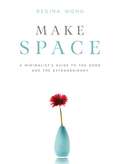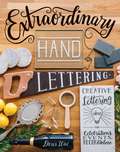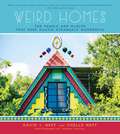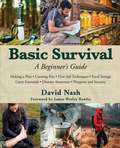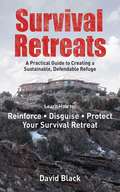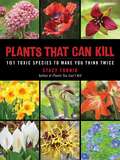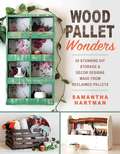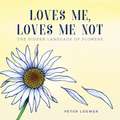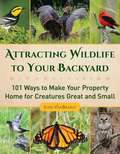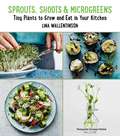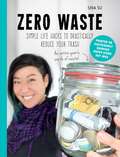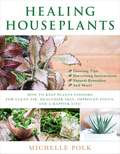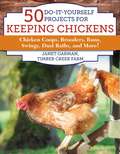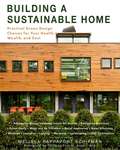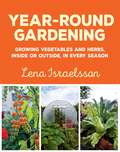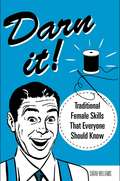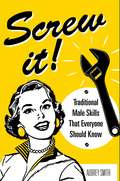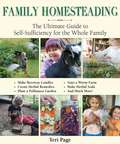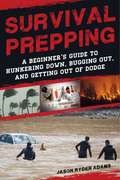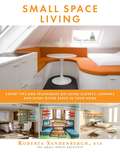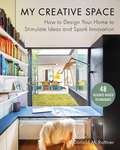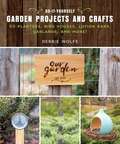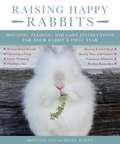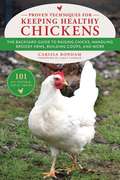- Table View
- List View
Make Space: A Minimalist's Guide to the Good and the Extraordinary
by Regina WongWe simply have too much stuff in our lives. Burdened by our heavy consumerist culture to continually own and consume without purpose, we lose ourselves to debt, dissatisfaction, and despair. If having more, doing more, and being more does not allow us to live abundantly, what can?Minimalism can make all the difference. A minimalist life removes non-essentials and clutter—whether it’s physical clutter in your home or a cluttered mental state that holds you back from your goals— and makes space for only the most important things that truly add value and joy. Make Space offers you the tools to achieve this transformative mindset shift by marrying minimalist philosophy and principles with practical tips, activities, and action points that will unlock truly simple living. Among others, learn how to:•Avoid “Stuffocation” by reducing unnecessary possessions•Declutter your home to create an ideal living space•Design and efficiently maximize minimalist budgets•Clear the mind of negative distractions and be intentional•Avoid emotional drains to be empoweredThe art of minimalism requires intentionally purging, building, crafting, and curating the type of life you’ve always wished you lived. And when you’ve finally removed all forms of clutter, you’ll invite all things good and extraordinary into your most intimate spaces.
Extraordinary Hand Lettering: Creative Lettering Ideas for Celebrations, Events, Decor, & More
by Doris WaiAre you a curious hand lettering beginner or long-time enthusiast looking to take your craft to the next level? Or are you a DIY guru or event planner wishing to breathe new life into a boring gift, event signage, or party décor? Extraordinary Hand Lettering opens your eyes to the endless possibilities in the world of creative lettering, showing you how to work with types of surfaces, such as wood, glass and acrylic, chalk, and even mirrors. First, learn the simple tools and tricks of hand lettering essentials—cursive and basic typefaces, creating balance and composition, and how to draw letters, as well as secret tips on what words you should choose to spotlight or shadow. Then, discover the lettering potentials of everyday items by transforming household objects or discarded items, such as old vintage mirrors, jewelry, and furniture, into a customized gift, unique decoration, quirky art piece, or stunning signage—all with the right lettering and choice of pen, pencil, or marker. For all DIY art-and-crafters, homemakers, and small business entrepreneurs, lettering is a versatile and necessary skill that can repurpose the old into something that is new, beautiful, and functional. Finally, draw inspirations from twelve whimsical projects suited for the girlie girl, the sophisticated man, or the modern minimalist. Combine the art of lettering and upcycling crafts to bring beauty into your everyday lifestyle.
Weird Homes: The People and Places That Keep Austin Strangely Wonderful
by David J. Neff Thanin ViriyakiHave you ever walked through your neighborhood, taken a look at a weird house, and thought “Who lives there?” or, “What in the world does it look like inside?” We’ve all been curious, which is why the founders of the Weird Homes Tour™ began their strange and wonderful journey. Three years later, they’ve opened the doors and unlatched the windows of dozens of Texas’s strangest homes for thousands of onlookers. Why? To show that design really has no boundaries. And that we would rather neighbors be strange than be strangers. Like many other communities around the world, Austin can be fun, irreverent, outside the box, innovative, dynamic, proud, strange, and so much more. You just need to know where to look. This gorgeous book features the one-of-a-kind Austin homes that started it all for the Weird Homes Tour. Page by page, we proudly present these homes and the weird people who live in them, many of whom designed and built their awe-inspiring dwellings by hand. From grand, historic haunts to treehouses and dumpster dwellings, you’re guaranteed to find something that will inspire design changes in your own home.
Basic Survival: A Beginner's Guide
by James Wesley Rawles David NashMany people are beginning to become concerned by increasing natural disasters, global conflict, and political unrest and the smart ones want to do something about it. Unfortunately, increased awareness about disaster preparedness has caused an information overload. It is easy to become overwhelmed by the sheer amount of information available. Basic Survival helps readers dig out from under the avalanche of preparedness information. It dispels myths, introduces concepts, and teaches the basics of how to start preparing for disaster. Author David Nash, a lifelong prepper and the author of 52 Prepper Projects and The Prepper’s Guide to Foraging outlines an all-hazards approach to disaster management similar to the ones used by the military and federal and state governments. Nash has over ten years of experience in government emergency management as a planner, a first responder, and as an emergency operations center manager. Basic Survival is a great resource that presents a strong foundation for being prepared when an emergency hits.
Survival Retreats: A Prepper's Guide to Creating a Sustainable, Defendable Refuge
by James C. Jones Dave BlackNormally, retreats are built to blend in to their surroundings for the sake of secrecy, and are built by those who don’t want others to know anything about their retreat. Dave Black explores these places and gets to go where most people never go—through the chain link fence, past the guard dog, and into the rarely seen survival retreat. Not only will you learn how to protect them, but you will learn how and where to build them, and most importantly, what to do after you’ve fortified. There’s a lot to know and with this book you’ll be prepared for the inevitable apocalypse . . .
Plants That Can Kill: 101 Toxic Species to Make You Think Twice
by Stacy TornioFollowing the success of Plants You Can’t Kill, Tornio now takes a look at those plants that can actually kill you if you’re not careful. This book will offer up information to gardening enthusiasts of all levels about common plants that are toxic, poisonous, and even deadly. While the level of toxicity varies from each plant, all are considered deadly in one way or another to wild animals, family pets, and even humans. With its colorful, easy-to-read format, Plants That Can’t Kill will introduce readers to what these plants look like, smell like, feel like, and sometimes even taste like. Fun facts, interesting tidbits, and history will combine to teach gardeners where these types of plants can be found, how poisonous each one is, and whether these plants are still okay to have in their gardens or if they should be gotten rid of immediately. Plants featured include many common and attractive species you may receive in bouquets or even decorate your homes with, including daffodils, irises, tulips, jasmine, witch hazel, mistletoe, poinsettias, buttercups, marigolds, and even fruits and vegetables like cherries, rhubarb, and some tomatoes.
Wood Pallet Wonders: 20 Stunning DIY Storage & Decor Designs Made from Reclaimed Pallets
by Samantha HartmanRustic meets modern with the charming DIY guide, Wood Pallet Wonders. This instructional collection of twenty incredible home design projects uses wood pallets and reclaimed materials to create eye-catching storage and décor. From the rustic Chevron Coffee Table and the beautiful Herb Garden to the stylish Bar Cart, beginner and veteran DIYers alike can take delight in crafting rustic projects that will impress and inspire without breaking the bank. With easy-to-follow, step-by-step instructions on crafting simple and stylish projects, you can add exquisite designs to your home or find inspiration for your own unique touch! The wide range of designs include: Rustic Night Stand Shabby Chic Toolbox Farmhouse Spice Rack Farmhouse Wall Clock Tealight Candle Holders And more! Take pride in creating imaginative home stylings with found and reclaimed materials that will help the environment, save you money, and make your home even more lovely!
Loves Me, Loves Me Not: The Hidden Language of Flowers
by Peter Loewer“A single flow’r he sent me, since we met. All tenderly his messenger he chose; Deep-hearted, pure, with scented dew still wet—One perfect rose.” —Dorothy Parker Welcome to the mysterious and sometimes scandalous world of the language of flowers. Since the days of Queen Victoria (and earlier the harems of the Middle East) flowers have allowed lovers and friends to express themselves without saying a word. In Loves Me, Loves Me Not, author and illustrator Peter Loewer explores the fascinating history of floral messages. In this book you'll find intriguing plant lore, unexpected historical connections, or simply an opportunity to connect with a beloved in a unique way. Confess unrequited love with a daffodil. Show happiness with primroses. Wish someone luck with a four-leaf clover. Make your declaration of love not with a rose, but with a tulip! With intriguing stories and stunning full-color illustrations, Loves Me, Loves Me Not, introduces you to flowers that have been conveying message for centuries. As Loewer says: "The language of flowers is a delightful idea. In the world of cell phones and mass communications, sending a simple bouquet that tells a tale of love and affection seems to be a great idea whose time has come again."
Attracting Wildlife to Your Backyard: 101 Ways to Make Your Property Home for Creatures Great and Small
by Josh VanBrakleMany people think of wildlife as something distant, creatures living in natural forests and remote public preserves. But most wildlife in the United States isn?t found in the distant wild. It lives on our private lands, in our very backyards. Because of this, America?s ten million woodland owners are in fact at the forefront in protecting US wildlife for generations to come. But while most landowners want to help preserve the beauty of the natural environment, most are unsure where to begin. In Attracting Wildlife to Your Backyard, author and landowner Josh VanBrakle provides readers with 101 easy-to-follow activities and practical approaches to help do just that. Some projects include:Installing a bat box Making a food plot Identifying trees that attract wildlife Forming a brush pile Assessing a stream's health Building a pond Learning bird calls Planning a backyard scavenger hunt Complete with stunning wildlife photographs and an appendix of practical resources, Attracting Wildlife to Your Backyard is an essential read for anyone who cares about the environment.
Sprouts, Shoots, and Microgreens: Tiny Plants to Grow and Eat in Your Kitchen
by Lina WallentinsonLearn how to grow (and consume) sprouts, shoots, and microgreens at home without using expensive or complicated equipment—all you need is tap water and a glass jar, and you’re ready to go! This is an easy, fast, and smart way to fit healthy greens into your diet. Following Lina Wallentinson’s instructions, in just a few days, you’ll see dry seeds transform into burgeoning green sprouts. In Sprouts, Shoots, and Microgreens, Wallentinson proves there is much more to shoots, sprouts, and microgreens than the classics cress and mung beans and that they are truly easy to grow, no matter where you try to do so. All plants in this book can be grown in jars, colanders, sieves, or bags at any height, using many different kinds of light sources, and even under pressure. In addition to showing how to grow shoots and sprouts, Wallentinson teaches how to make delicious meals with your harvest. Using step-by-step pictures and descriptive recipes, she demonstrates that shoots and sprouts are much more than just decorations on a plate. Recipes include sushi rolls with quinoa and wasabi mayonnaise, baked pumpkin with lentil sprouts and almond pesto or coffee, and coconut balls with toasted buckwheat!
Zero Waste: Simple Life Hacks to Drastically Reduce Your Trash
by Shia SuEasy and Effective Strategies to Jumpstart a Sustainable, Waste-Free Lifestyle We have a worldwide trash epidemic. The average American disposes of 4.4 pounds of garbage per day, and our landfills hold 254 million tons of waste. What if there were a simple—and fun—way for you to make a difference? What if you could take charge of your own waste, reduce your carbon footprint, and make an individual impact on an already fragile environment? A zero waste lifestyle is the answer—and Shia Su is living it. Every single piece of unrecyclable garbage Shia has produced in one year fits into a mason jar—and if it seems overwhelming, it isn’t! In Zero Waste, Shia demystifies and simplifies the zero waste lifestyle for the beginner, sharing practical advice, quick solutions, and tips and tricks that will make trash-free living fun and meaningful. Learn how to: Build your own zero waste kitPrepare real food—the lazy wayMake your own DIY household cleaners and toiletriesBe zero waste even in the bathroom!And more! Be part of the solution! Implement these small changes at your own pace, and restructure your life to one of sustainable living for your community, your health, and the earth that sustains you.
Healing Houseplants: How to Keep Plants Indoors for Clean Air, Healthier Skin, Improved Focus, and a Happier Life!
by Michelle PolkWhat if the beautiful plants in your home could also become a part of your health routine? Houseplants add vibrancy to any home or office, but many also have significant health benefits you may not even know about. That aloe plant sitting on your window sill can be used as an ointment for scrapes, bruises, and sunburns. A chamomile plant—with its pretty display of white flowers—might be your cure for restless sleep and anxiety. A lavender plant will make your bathroom smell delightful, and can also be used as a stress relief medicinal. There are a number of houseplants that are easy to grow indoors and that reduce stress, increase productivity, speed up healing, lower depression, increase overall happiness, and filter our air from carcinogenic pollutants. Learn which plants have which health benefits and then find out how to care for them effectively in your home or office. Aloe soothes skin irritations and is excellent for stomach health Rosemary can slow hair loss and enhance memory Chamomile balances blood sugar and is an antibacterial Sage can easy muscle aches and bring mental clarity Dandelions can improve digestion Calendula can reduce skin inflammation Learn how to make your houseplants thrive and how to utilize them for your health!
50 Do-It-Yourself Projects for Keeping Chickens: Chicken Coops, Brooders, Runs, Swings, Dust Baths, and More!
by Janet GarmanGet ready to jump into the world of chickens, one DIY project at a time. Owning and raising chickens doesn’t have to be an expensive hobby. With imagination, simple tools, and salvaged or bargain materials, you can make everything your flock needs for their health and safety.Buying a chicken coop can be a major expense. Follow the steps provided in the book to retro fit an existing structure into a chicken palace fit for the fanciest hens. Brooders, grow out pens, and chicken runs can easily be pulled together and give your feathered family a safe place to scratch and peck.If your chickens want fun activities, create boredom busters with the directions for a chicken swing, dust bath, outdoor roosts, front porches, and resting perches. Are you planning to raise your own sustainable flock? Building a nesting box area fit for the best broody is included. You can even set up a maternity ward and brooder pen in the coop. Dropping boards to dust baths, feeding stations to first aid, read and learn the simplest ways to provide the infrastructure and fun that your chickens need to grow and thrive. After all the project building, and chores are done, treat your flock to a delicious seasonal recipe with one of the recipes included.From beak to talon, you’re ready to tackle the needs of your flock with 50 DIY Projects you can create on a limited budget. Let’s get started!
Building a Sustainable Home: Practical Green Design Choices for Your Health, Wealth, and Soul
by Schifman MelissaThe green building movement has produced hundreds of “how-to” books and websites that are filled with tips about green building and what homeowners should do to go green. While helpful and informative, when it comes to making actual purchasing and installation decisions, these books do not make it any easier for a homeowner to prioritize against a budget. The Sustainable Home serves this need, as it is written by a sustainability advisor and financial advisor who has personally directed the building and LEED certification of her own home. Here, she shares her knowledge and experience for others to use in their journey toward a greener way of living. Whether the reader is building a new home or doing a minor remodel, a homeowner needs a framework by which to guide their decisions. These decisions are based on values, and the author posits that there are really only three reasons to go green: For Our Health: By building more sustainably, we reduce our exposure to harmful chemicals and toxins. For Our Wealth: By building a more durable home and being more efficient with resources like water and electricity, we reduce our monthly utility bills and ongoing maintenance expenses. For Our Soul: Collectively doing the right thing for our planet does make a difference—and that is soul-nourishing. Learn the logistics of choosing windows, insulation, appliances, and lighting. Find out about FSC certified wood and about using reclaimed materials. Here is everything you need to make your home sustainable.
Year-Round Gardening: Growing Vegetables and Herbs, Inside or Outside, in Every Season
by Lena IsraelssonWant to get home-grown spices in the middle of winter? Eat fresh vegetables in the spring? Sow in the summer to harvest in the fall? Lena Israelsson's book, Year-Round Gardening, is a practical guide for those who want to extend their growing season. And double, perhaps triple, their harvest. Growing year round is possible, and this book can teach you the best methods to do it the right way.Year-Round Gardening includes inspiring and expert tips on which vegetables, herbs, and spices suit the different seasons. Certain plants can even be harvested in the middle of winter if handled correctly. Others, like microgreens, herbs, and hydroculture, can create the perfect indoor gardens. This book will teach readers to know the difference between cold and hot weather plants, which growing methods are best suited for different plants, and when to plant and harvest. They’ll learn about sowing; coverage with plastic, glass, or fiber weaves; and fertilization—creating a fruitful and fertile soil is the linchpin of all cultivation and one of the book's most important parts.
Darn It!: Traditional Female Skills That Everyone Should Know
by WilliamsCan you sew on a button? Or wrap a present? Worry not—Darn It! is here to help you master such tasks with ease to expand your repertoire and skill set, making you a more well-rounded, twenty-first-century man. Easy to navigate, this instruction manual helps you take matters into your own hands. There’s no shame in knitting your own scarf or hat, especially if it means achieving complete self-reliance. The tips and instructions in this book will teach you how to: Iron a shirt Clean your silverware Apply a bandage Use a sewing machine Make an omelet And much more! Beautifully illustrated, with clear and concise step-by-step instructions, this essential handbook is the ultimate survival guide for the modern man.
Screw It!: Traditional Male Skills That Everyone Should Know
by SmithHave you ever wondered how you’d survive without a man to attend to the odd jobs around the house? Have you ever wished you knew how to put up a shelf or check the oil in your car? And, more importantly, not have to call a man around to help? Then this is the book for you! From changing a car tire and checking brake fluid and coolant to building a campfire, Screw It! features traditionally male skills to help you learn invaluable information. Divided into sections focusing on vehicle maintenance, the home, the garden, and the great outdoors, each task is concisely explained and accompanied by beautifully illustrated instructions. Never again will you need to rely on men! This essential guide will help you become a completely self-sufficient and independent woman in today’s world.
Family Homesteading: The Ultimate Guide to Self-Sufficiency for the Whole Family
by Teri PagePractical advice and hands-on projects for the self-sufficient family In an increasingly digital world, families are looking for ways to deepen their connection to one another and to the land. The Family Homestead is a guide to a simpler life, one that integrates children into the daily work of creating a sustainable homestead. From gardening and cooking, to herbalism and natural crafts, The Family Homestead shares stories and hands-on projects that will deepen relationships and build self-sufficiency skills. Teri Page, author of the popular Homestead Honey blog, moved with her husband across country with young children to build their off-the-grid homestead on raw land. Together, they garden, forage, preserve foods, raise chickens, homeschool, and so much more. Perfect for homeschooling families or anyone working with or raising kids, readers will learn how to involve children in dozens of homesteading projects. Learn how to: Dye cloth with plant-based dyesMake beeswax candles Construct a rain barrel Hatch chicks Create a worm farm Grow giant pumpkins Make butter in a mason jar Make homemade herbal soda And so much more!
Survival Prepping: A Guide to Hunkering Down, Bugging Out, and Getting Out of Dodge
by Jason Ryder AdamsFood, Water, First Aid, and Self-Defense Tips for Surviving Natural Disasters, Extreme Weather, Pandemics, Biological Threats, Terrorist Attacks, and Riots It could be a fire, flood, hurricane, tornado, or hailstorm. Financial system collapse or bioterrorism. Governmental shutdown or societal breakdown. The world is full of possible threats, and they seem to be coming at us from all sides these days. Jason Ryder Adams covers everything you need to know prepare your home, keep your family safe, and get ready to leave if the worst happens. You’ll learn how to: Prep with children and pets (and do test runs ahead of time)Plan for staying put, sealing yourself in, and leaving depending on the threatChoose and protect a safe location and develop an escape routeDefend your family with self-defense training and firearmsPut together a 72-hour emergency kit, bug-out bag, and first aid kit So don’t panic—prepare! Prepping today is for everyone. Survival Prepping is written for ordinary folks who want to get started on preparing for the worst. Adams shares bug-out plans for every scenario, safety tips, and invaluable checklists for acquiring the right supplies for emergency situations. Survival Prepping will help you ensure your family survives—and hopefully thrives—should a disaster strike.
Small Space Living: Expert Tips and Techniques on Using Closets, Corners, and Every Other Space in Your Home
by Roberta SandenberghComplete with demonstrative illustrations and photographs, Small Space Living offers more than one hundred space-saving ideas from Roberta Sandenbergh, a.k.a the Small Space Architect.Sandenbergh will introduce you to the idea of space opportunities—untapped areas in every home that can be expanded for storage and organizational purposes. A space opportunity might be as simple as using an empty space under a stairway or above a doorway or as complicated as dividing your entire apartment for rental income.Each chapter addresses a different kind of space opportunity area, including closets, corners, walls, windows, ceilings, and floors. In these areas, you will be inspired by Sandenbergh’s creative approaches to divided spaces, stacked spaces, empty spaces, mirrored spaces, and multipurpose furniture. Learn from the author’s stories of her own designs for “small-by-choice” homes—for herself and for her clients—in which she tried to make the best possible use of varied living spaces. Allow Sandenbergh to help you create more space-efficient and attractive areas in your home whether you live in a studio apartment, a tiny home, or a larger home that needs more of a cozy feel.
My Creative Space: How to Design Your Home to Stimulate Ideas and Spark Innovation
by Donald M. Rattner48 Techniques to Boost Your Creativity at Home, According to Science A great deal of psychological and productivity research has gone into discovering how the design of the physical environment can improve creative performance, yet nearly all of it has focused on the workplace, commercial spaces, and schools. What has been largely overlooked is the one place we spend more time in than anywhere else and where more people than ever are now working: the home. My Creative Space shows how readers can boost their creative output by applying science-backed techniques to the design and decoration of their home regardless of size, type, style, or location. With over 200 stunning color photographs of creative spaces, including many designed by top architects and interior decorators, this lavishly produced book will inspire readers while offering practical and specific ways to transform your own home into a creative haven. Readers will: Learn practical techniques to shape a home for peak idea generationAcquire insights into how everyday activities at home can boost creative performance at work, play, and schoolDiscover hands-on household products designed to foster creative skillsGain a new understanding of the meaning and psychology of creativity Read about the best lighting to foster a creative environment, how to use walls to capture ideas, why round shapes spur greater creativity than straight lines, the benefits of incorporating nature into your surroundings, and more. Whether you're an artist, design professional, writer, entrepreneur, work in a creative industry, or pursue a personal passion for pleasure, this book is an invaluable guide for turning living space into creative space.
Do-It-Yourself Garden Projects and Crafts: 60 Planters, Bird Houses, Lotion Bars, Garlands, and More
by Debbie WolfeImprove Your Garden and Home with Easy DIY Projects and Beautiful Botanical Crafts Create your dream garden with simple bird baths, herb drying racks, and unique planters. And bring the outdoors indoors with natural fabric dyes, pressed flower paper, and herbal bouquets. <P><P>DIY Garden Projects and Crafts book relies on home grown and foraged materials that will inspire creativity and capture the bounty of the seasons. The sixty practical and decorative projects for use in the garden and home include: <br>Gardener's Tool Apron <br>Metal garden charms <br>Veggie Market Tote <br>Macrame produce bag <br>Gourd bird feeder <br>Kirigami leather hanging planter <br>Tomato cage plant stand <br>Shibori Dyed Fabric <br>Herbal lotion bars <br>Gardener hand scrub <br>All-purpose thyme cleaner <br>And more! <P><P>Do-It-Yourself Garden Projects and Crafts features detailed, step-by-step instructions as well as simple crafting and gardening tips that will make your projects successful.
Raising Happy Rabbits: Housing, Feeding, and Care Instructions for Your Rabbit's First Year
by Penny Ausley Brittany MayA practical and information-packed guide for purchasing and raising pet rabbits So, you’re thinking about buying or adopting a pet rabbit. Wonderful! Or maybe you’ve already brought a fuzzy bundle of joy home and you’re realizing you could use a little guidance. <P><P>Rabbits are adorable and soft and fun, but they also require a fair amount of work and knowledge to make sure they’re living a happy, healthy life. With the right approach, you will soon discover that your new pet rabbit can become your best pet ever. With time, attention, and patience, a deep bond can develop and you will be friends “furever.” <P><P>Raising Happy Rabbits will help you choose the right kind of rabbit for your home (if you haven’t already picked one), and answer your questions about housing, litter training, proper feeding, exercise, freedom, grooming, potential illnesses, playtime activities, what is normal/abnormal behavior, and much more. <P><P>Learn all about: Finding a vet Choosing an appropriate cage Pellets, hay, and fresh foods Growing herbs and lettuces for your bunny Toys to keep your rabbit engaged Illnesses to watch for And more! Make your first year with your bunny a fun and fulfilling experience that will bond you and your new rabbit for life.
Proven Techniques for Keeping Healthy Chickens: The Backyard Guide to Raising Chicks, Handling Broody Hens, Building Coops, and More
by Carissa BonhamBeginning and intermediate chicken keepers don’t need to spend hours poring through extensive manuals and thick books—Carissa Bonham boils down chicken-keeping basics into 101 easy-to-understand and easy-to-apply tips, tricks, and chicken hacks. Advice ranges from learning how to grow your flock despite having a broody hen to directions for making a nesting box herb blend that will keep pests at bay and keep the coop smelling fresh. Other tips will touch on: • Waiting for info from author • Waiting for info from author • Waiting for info from author • And much more! Having raised a variety of chickens both inside her home and with the help of broody chicken moms, author Carissa Bonham is ready to share her chicken-keeping advice with others looking to add the joy of poultry to their lives. Her approach to chicken keeping focuses on keeping hens happy using natural methods so you can spend less time doing the dirty work and more time enjoying your flock.
150 Survival Secrets: Advice on Survival Kits, Extreme Weather, Rapid Evacuation, Food Storage, Active Shooters, First Aid, and More
by James C. JonesAs the world gets more dangerous, you have to be prepared for anything, even the worst. In 150 Survival Secrets, seasoned survivalist James C. Jones provides insider tips to help you and your family survive any catastrophe. Divided into practical sections, 150 Survival Secrets answers every question you’ve ever had about disaster preparedness. One section lists the practical details of making it through any kind of emergency situation. Some topics include: How to survive extreme winter conditionsHow to put together a homemade survival kit in the case of an emergencyHow to safely evacuate from an urban area during a disasterHow much and what type of food to store at home for long-term emergenciesHow to survive an active shooter situationHow to treat common injuries. Other sections answer everything you’ve ever wondered about disaster prepping, including what being a survivalist entails, how to equip your home for survival situations, what gear is essential for a survivalist to own, what elements are essential in a good emergency plan, what types of disasters you can expect to face in your lifetime, and more. So what are you waiting for? With 150 Survival Secrets, you’ll be prepared for anything and everything.
